

Vol. 40 (Issue 40) Year 2019. Page 20
KOSTENKO, Olga Vladimirovna 1
Received: 03/08/2019 • Approved: 05/11/2019 • Published 18/11/2019
ABSTRACT: The paper presents an analysis of the Russian experience in the formation of cluster networks, made according to the project “Cluster Map of Russia”. Some problems of organizational development of clusters have been identified. Russian clusters lack critical mass. Half of the clusters do not have development strategies and programs, and the issues of financing their management companies have not been resolved. One-third of the clusters have no websites. Most cluster websites are rarely updated or are not updated at all. For further development, it is necessary to train skills in networking and attract governmental subsidies for activities aimed at developing cluster networks. |
RESUMEN: El artículo presenta un análisis de la experiencia de Rusia en la formación de redes de clúster, realizada sobre la base de datos del proyecto "Mapa de clústeres de Rusia". Problemas identificados de desarrollo organizacional de clústeres. Los clústeres rusos carecen de la masa crítica. La mitad de los clústeres no tienen estrategias y programas de desarrollo. No se resuelven las empresas de gestión de problemas financieros. Un tercio de los clústeres no tienen sitios. La mayoría de los clústeres tienen sitios web que raramente se actualizan o no se actualizan. Para promover su desarrollo, es necesario la capacitación en habilidades de trabajo en red, así como la captación de subsidios gubernamentales orientados a actividades para el desarrollo de redes de clúster. |
The development of the world economy in recent decades has been characterized by an increase in the turbulence of the external environment. The pace of scientific and technological development is accelerating, followed by the complexity of organizational structures. The search for innovative development opportunities inevitably goes beyond the scope of individual enterprises and is increasingly being conducted at the interfaces of sciences, technologies, and industries.
Naturally, this leads to the emergence of network forms of business organization. Organizational structures evolve from functional organizations to divisional, matrix, and network organizations. Initially, network organizations began to emerge in global markets with an aggressive external environment. Now it happens everywhere (Smorodinskaya, 2015). In contrast to the hierarchical structures, network organizations are formed as a network of independent suppliers and consumers, each specializing in those areas of activity where it has the greatest competencies. An open dynamic system arises that is capable of supporting continuous innovation (Castells, 2001). One particular type of network organization is clusters.
With regard to clusters, there is a surprising consistency in a number of economic theories (Smorodinskaya, 2015), which, based on different concepts, models and points of view, explain the emergence of economic clusters and the logic of their development. The main ones are:
- the theory of spatial development and localization of production, starting with the theory of industrial areas of Marshall (1890), the theory of "growth poles" of Perroux (1970), the theory of agglomerations of Krugman (1991) and a number of others;
- theories of innovation development, for example, the theory of spatial diffusion of innovations (Hagerstrand, 1967), the triple helix model – network partnership of the state, business and science (Etzkowitz, Leydesdorff, 1995). At the same time, there is a tendency of localization of innovation processes in specific territories. In many economies of the world, regional innovation ecosystems (clusters) are being formed, including those designed for leadership on a global scale (Bramwell et al., 2012);
- the theory of competitive advantage (Porter, 1990), according to which the center of competition is shifting from individual enterprises to the level of geographically concentrated groups of interconnected enterprises (clusters).
Thus, we can see direct connections and the absence of contradictions in the description of clusters between theories of network organization, theories of localization of production facilities, theories of innovative development and theory of competitive advantage. Due to diverse approaches, a more complete and objective understanding of the nature of clusters and their development factors is emerging.
This means that the cluster approach as a method of stimulating economic growth through cluster support should be based on a comprehensive description of clusters. Three dimensions of clusters are considered being core (Markov et al., 2015; Tarasenko, 2013; Aleksandrova, Matveeva, 2014; Kostenko, 2018):
- geographical aspect – territorial localization or concentration of economic agents in a compact territory;
- economic aspect – functional connectedness of participants or proximity according to the profile of economic activity;
- network aspect – features of the business environment and the formation of sustainable intercompany and inter-organizational networks. Only in the presence of all the signs of a cluster organization, one can talk about the formation of a cluster and subsequent cluster effects.
Studies show that the network aspect is most critical for cluster formation. (Markov et al., 2015 Therefore, the goal of cluster policy is to a greater extent the support and creation of enterprises network associations, the removal of barriers to networking; Tarasenko, 2013), the establishment of cooperation institutions (Begun, Markov, Yagolnitser, 2007). In different countries and clusters, this role is played by special structures – government agencies and cluster management companies (Smorodinskaya, 2015; Porter, Ketels, 2009; Zabuga, 2015). The competitiveness and development of clusters are largely determined by the way they are created (“from the top down” or “from the bottom up”), the management system and the financing model (Meier zu Köcker, 2009).
In transitional and developing economies, the overall development of the business environment and the task of forming networking are even more important. First, such countries are characterized by a low level of trust between economic agents and weak trust in the state (Sölvell, Lindqvist, Ketels, 2003). It is believed that in such countries, cluster policy should primarily be aimed at developing a culture and skills of networking, as well as developing networks (Smorodinskaya, 2015). A major problem in countries with developing economies is the dominance of the state in cluster initiatives, which negatively affects the formation of full-fledged cluster networks (Ketels, Lindqvist, Sölvell, 2006). The functions of authorities should not be reduced to the direct “creation of clusters”, but should focus on supporting existing cluster initiatives and the emergence of new ones (Begun, Markov, Yagolnitser, 2007).
The aim of this study is to analyze the Russian experience in cluster formation and development: the creation and financing of cluster management companies, their activities and methods of cluster organizational development.
The theoretical basis of the study was the research on the theory of cluster development. The research data of the European Cluster Observatory (Green Books 2003 to 2013), the Russian Cluster Observatory (HSE), including in conjunction with the CSR Foundation “North-West”, on pilot territorial innovation clusters were used.
As an empirical information base for the study, the author used open data from the project of the Russian Cluster Observatory “Cluster Map of Russia”, cluster sites (cluster management companies, regional authorities and development institutions). Observations were carried out as of May 2018.
In the global practice, the main focus has initially been the formation of cluster networks. Thus, studies of the European Cluster Observatory (Sölvell, Lindqvist & Ketels, 2003) revealed six main types of tasks for cluster initiatives. The method of interviewing the representatives of clusters determined the frequency of that choice made by the initiators. The highest priority was given to the task of forming intercompany and interpersonal networks of the cluster (96% of respondents). The issues of state support for clusters (state regulation measures, lobbying of infrastructure and subsidies for the cluster) received medium priority. Low status was given to tasks to reduce competition in the cluster and reporting. This is at variance with the modern Russian practice.
In 2004, a group of European clusters initiated the CLOE: Clusters Linked over Europe project. Based on the experience of successful cluster initiatives in Europe, the Cluster Management Guide standards have been developed. In fact, this is a complete practical guide, with an overview of the main tasks of creating clusters. This project also relates the formation of cluster networks to the key tasks of cluster management and considers the cluster initiatives per se as “organized regional sector networks between economic partners aimed at improving innovation and international competitiveness” (INTERREG IVC, 2004). The guideline contains a detailed description of the content and sequence of actions to form clusters. Most of the activities of cluster management companies are also aimed at building networks: information and communication events; education and advanced training; cooperation support; marketing and public relations; internationalization.
PRO INNO Europe Initiative's study on European clusters (Innovation Clusters in Europe, 2006) also showed that network collaboration as a method of cluster development has the highest priority. The method of lobbying the interests of the cluster received the lowest rating (differing from the Russian practice). A subsequent study of European clusters (Lindqvist, Ketels & Sölvell, 2013) confirmed previous findings. In developed countries, cluster policy focuses on building localized networks.
Zabuga (2015) cites as an example the data for the Forest Cluster Management Research Company (Finland). The permanent team supports the cluster information infrastructure (website, catalog of companies, cooperation exchange, etc.), communication platform (regular meetings and events, company visits, workgroups, cluster days, etc.), has a budget using the state and private financing. All this corresponds to the best examples of supporting cluster initiatives in Europe.
Russian research using case studies of pilot clusters reveal significant differences from world standards. HSE and the Center for Strategic Research “North-West” Foundation (2014) conducted an analysis of the activities planned by clusters. Most of the clusters included communication activities, creation and maintenance of websites, advanced training, participation in international foreign exhibitions. They planned some measures to attract investment in projects of cluster members, as well as measures for integration into European clusters, creation of a project office for the implementation of cluster projects.
However, in general, as noted by Gokhberg & Shadrin (2015), the directions and objectives of the development of pilot clusters do not fully comply with the methodological approaches of Green Book – 2003, although they are comparable with them. An analysis of the pilot cluster development programs showed little attention to organizational development. To a certain extent, this is the result of the fact that the teaching materials do not contain detailed recommendations and examples of measures for creating cluster networks.
Markov, Kurmashev & Nizkovsky (2017) analyzed the experience of regional cluster policies studying the cases of the leading regions of the cluster movement (the Samara, Lipetsk, Moscow and Tomsk Regions, the Republics of Tatarstan and Mordovia) and came to the conclusion that cluster policy at the regional level is at a very early stage of formation. According to researchers, well-organized clusters are “not the result of focused efforts”, but are the result of evolutionary ties between cluster members. This once again emphasizes the importance of networking for cluster development.
The fact that the construction of networks in clusters is not efficient enough in Russian clusters is confirmed by studies (Kutsenko, 2015). In foreign practice, in 80% of cases, the priority is the relationship between cluster companies; in the second place, there is the relationship “company – scientific organization” and “company – educational institutions”. Russian clusters set priorities for interaction in a different way. The highest priority is given not to interaction with business, science or education, but to the state (60%).
As of May 2018, profiles of 115 clusters were placed in the database of the “Cluster Map of Russia” project, including 28 pilot and 9 industrial clusters. The scatter of clusters by the number and size of cluster members is shown in Figure 1.
Figure 1
Cluster map by the number of members
and the average size of the enterprise
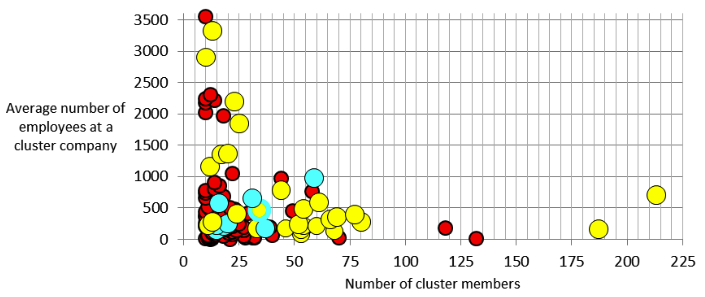
Legend: - yellow circles – pilot innovation territorial clusters;
- blue circles – industrial clusters;
- red circles – other.
Source: The “Cluster Map of Russia” (URL: http://map.cluster.hse.ru/)
From the standpoint of the cluster theory, it is preferable when a cluster consists of a large number of small and medium-sized enterprises. In reality, everything is somewhat different. Almost half of the clusters (50) are those with a small number of members (up to 25) and small size of enterprises (up to 500 employees). The group of clusters consisting of a small number (up to 15) of very large enterprises (1,500-3,500 employees) is noteworthy. The third small group consists of clusters with a significant number of members (over 100) of small enterprises (up to 500 employees).
The distribution of clusters by objects of cluster initiative is presented in Figure 2. The estimates are based on data on the officials who signed the contracts/agreements on the creation of clusters.
Figure 2
Objects of cluster initiative
(number of clusters)
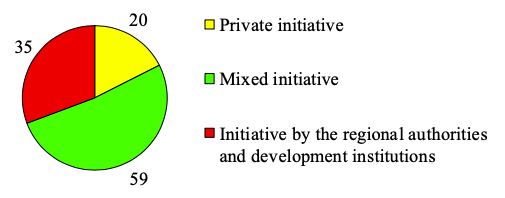
Source: The “Cluster Map of Russia” (URL: http://map.cluster.hse.ru/)
Most of the clusters in Russia are created with the participation of regional authorities or development institutions (ministries, development corporations, small business support foundations, etc.). Every third cluster was created by the initiative of government bodies. This is in line with the global practice of cluster initiatives (Lindqvist, Ketels & Sölvell, 2013).
However, the creation of cluster management companies in Russia is significantly different from world standards. In the world (Sölvell, Lindqvist & Ketels, 2003), 65% of cluster initiatives are registered as a separate legal entity (or a unit within a legal entity), and only 35% of clusters operate as an informal organization. In Russia, the situation is opposite. Almost 75% of Russian clusters operate on the basis of contractual relations and do not create a management company. Not surprisingly, the functions of cluster management companies in most cases are assigned to government bodies (Figure 3). Over the past year and a half since the period of previous observations (Kostenko, 2017), the situation has not changed.
Figure 3
Types of cluster management companies
(number of clusters)
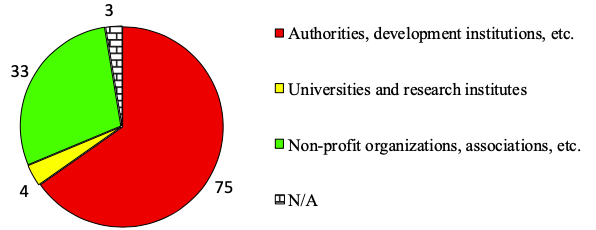
Source: The “Cluster Map of Russia” (URL: http://map.cluster.hse.ru/)
Most often, the functions of a management company are assigned to regional Cluster Development Centers (Novgorod Region), development corporations (Perm Territory), technology parks (Kemerovo Region), foundations for supporting small and medium-sized enterprises (Irkutsk Region), etc. There are some cases when the functions of a management company are entrusted to regional ministries (Volgograd Region, Tula Region, etc.). Each region uses its own “template” of the cluster management company, with the exception of only St. Petersburg.
Unfortunately, all this negatively affects the organizational development of clusters and the formation of cluster networks. So, only half of the clusters have development strategies or programs (Figure 4).
Figure 4
Strategic documents of clusters
(number of clusters)
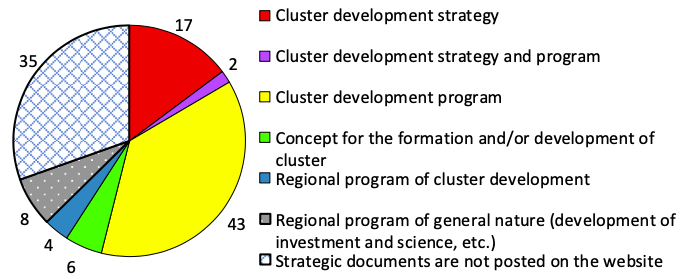
Source: The “Cluster Map of Russia” (URL: http://map.cluster.hse.ru/)
The clusters' openness to interaction can be assessed by their websites. Only 44% of clusters support their own sites (or sites of management companies). Every fifth cluster uses a simplified version – a cluster page on the site of the Center for Cluster Development (a small amount of information, rarely updated). Every third cluster does not have a website (Figure 5).
Figure 5
Websites options
(number of clusters)
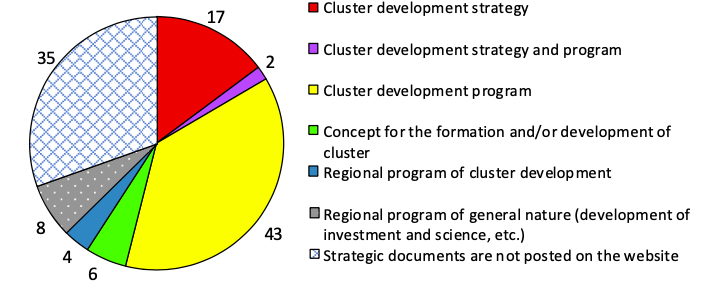
Source: The “Cluster Map of Russia”
(URL: http://map.cluster.hse.ru/)
The quality of the website was evaluated by the newsfeed (Figure 6). It turned out that only a third of the clusters (which have websites) regularly update the news (at least weekly). A third of clusters do not keep any newsfeed.
Figure 6
Last newsfeed update on websites
(number of clusters)
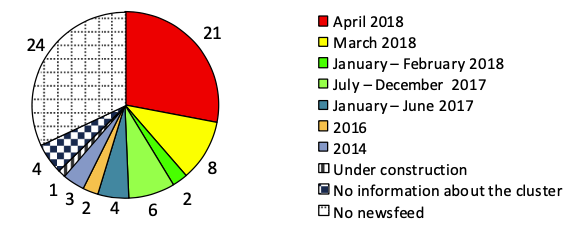
Source: The “Cluster Map of Russia” (URL: http://map.cluster.hse.ru/)
The data presented indicate a low level of planning and implementation of measures for the organizational development of clusters. The author evaluate their content on the basis of an analysis of cluster strategic documents (strategies, programs, and development plans). An analysis of the activities planned by the clusters showed that the general formulations and template guidelines from the methodological recommendations prevail.
As showed by the analysis of the data, the basis of the problems is the quality of cluster initiatives. If the cluster initiative comes “from the bottom” – from business, science or education; in such cases, much more often than the average in total, those clusters establishes its own management company. Moreover, in most cases (70%) it is a management company in the form of a non-profit partnership or association, and sometimes a university takes on these functions. In other cases, the functions of management companies are performed by regional development institutions (Figure 7).
Figure 7
Impact of cluster initiatives on
the type of management company
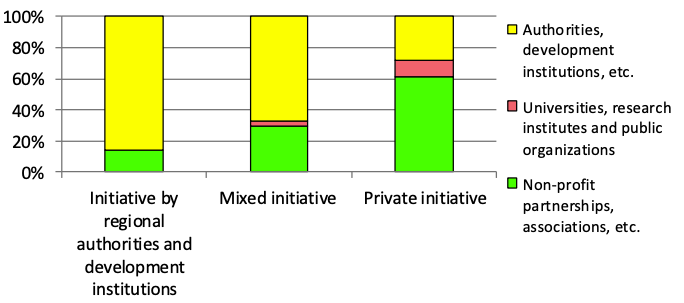
Source: The “Cluster Map of Russia” (URL: http://map.cluster.hse.ru/)
The form of cluster creation and the type of cluster management company, in turn, affect the formation of cluster networks and organizational development. Thus, cluster management companies often run cluster websites (Figure 8).
Figure 8
Impact of the form of creating a cluster on
website maintenance (number of clusters)
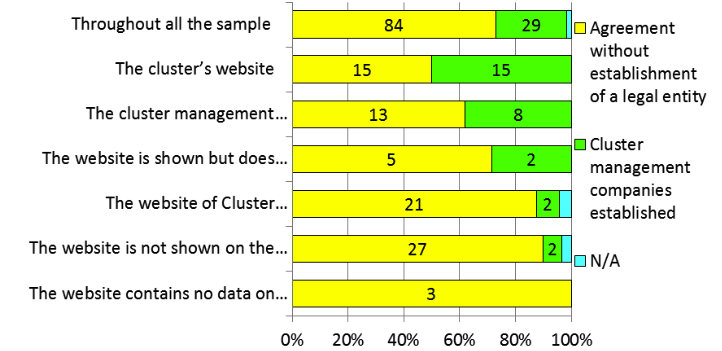
Source: The “Cluster Map of Russia” (URL: http://map.cluster.hse.ru/)
The cluster creation form also influences such an important aspect as financing cluster initiatives (Figure 9). In the presence of a management company, clusters more often form a common budget. This form provides more sustainable financing for events such as maintaining a website, information database, mutual visits to companies, workgroups, forums, and the launch of joint cluster projects.
Figure 9
Impact of the form of creating a cluster
on financing (number of clusters)

Source: The “Cluster Map of Russia” (URL: http://map.cluster.hse.ru/)
In turn, the formation of the overall budget affects the number of cluster projects planned and implemented.
An analysis of Russian cluster initiatives for a total of more than 100 clusters, information on which is available in the “Cluster Map of Russia”, revealed a number of problems and negative trends in their organizational development.
Firstly, some confirmation was obtained on the dominance of the state in cluster processes and the weaknesses of initiatives “from the bottom” on the part of cluster members:
- 94 cluster initiatives (82% of the total) – either regional governments initiated the creation of clusters or their partners did;
- 84 clusters (73%) were created in an “easy” format (an agreement without forming a legal entity), 75 clusters (65%) did not create management companies, their functions were assigned to various regional development institutions.
Secondly, Russian clusters are still characterized by a low level of cluster network formation:
- clusters consist of a small number of members (on average 30 members per cluster, only in 4 clusters the number of members exceeds 100). Russian clusters clearly lack a “critical mass”;
- the main focus is on the preparation and signing of the agreement of members on the creation of clusters. Development strategies and programs have been adopted in only half of the clusters. Even fewer clusters actually develop cluster networks;
- 50% of clusters have not resolved the issues of financing management companies and joint activities; 35% of clusters do not have websites; most websites (72%) are rarely updated or not updated at all.
Unfortunately, the study confirmed that in Russian practice, the key dimension of a cluster – cluster networks and their development – is largely ignored. From the side of regional governments, efforts are mainly directed to formal procedures for creating clusters. For cluster members, the leading motive for creating a cluster is the possibility of obtaining governmental support.
It seems that under these conditions, solutions are possible in a number of directions. First, to operate in network structures, which include clusters, new skills and competencies are needed: change management skills, ability to build communications, competencies in collaboration and teamwork . These requirements are presented not only to the personnel of organizations participating in a cluster, but to the full extent to employees of state bodies. The business expects from the authorities the ability to conduct a dialogue and interact with business as partners, but not from the perspective of “benefits giveaway”. The state will have to learn how to create conditions and stimulate the development of cluster networks “from the bottom to the top”, rather than govern the creation of clusters “from the top”. Second, it is proposed to develop a new direction of cluster policy – subsidizing of the measures aimed at the formation of cluster networks, including co-financing of cluster management companies.
Aleksandrova L.A., Matveeva O.V. (2014). Institutional approach to cluster studies. Agrarian Scientific Journal, № 10, 65-69. Retrieved from: https://elibrary.ru/item.asp?id=22286737
Begun I.V., Markov L.S., Yagolnitser M.A. (2007). The role of associations in the organization of clusters // Bulletin of the NSU. Series: Socio-economic sciences, vol.7, №1, 42-46.
Bramwell A. et al. (2012). Growing Innovation Ecosystems: University-Industry Knowledge Transfer and Regional Economic Development in Canada. Final Report to the Social Sciences and Humanities Research Council of Canada (p.63).
Castells M. (2001). The Internet Galaxy. Reflections on the Internet, Business and Society. Oxford: Oxford University Press (p.292).
Etzkowitz H., Leydesdorff L. (1995). The Triple Helix - University-Industry-Government Relations: A Laboratory for Knowledge-Based Economic Development. EASST Review,vol. 14, №1, 14–19.
Gokhberg L.M., Shadrin A.E. (2015). Pilot innovative territorial clusters in the Russian Federation: directions for the implementation of development programs. Moscow: HSE (p.92).
Hagerstrand T. (1967). Innovation diffusion as a spatial process. Chicago: University of Chicago Press (p.333).
HSE and the North-West CSR Foundation. (2014). Management system for management companies of innovative territorial clusters of the Russian Federation. RVC official website. Retrieved from: https://www.rvc.ru/upload/iblock/946/201403_management_companies_clusters.pdf.
Innovation Clusters in Europe: A statistical analysis and overview of current policy support. (2006). Luxembourg: Office for Official Publications of the European Communities (p.65).
INTERREG IVC. (2004). Cluster Management Guide – Guidelines for The Development and Management of Cluster Initiatives. INTERREG IVC. Retrieved from: http://www.interreg4c.eu/uploads/me-dia/pdf/2_Cluster_Management_Guide_CLOE.pdf
Ketels C. H. M., Lindqvist G. and Sölvell Ö.(2006). Cluster Initiatives in Transition and Developing Economies. Center for Strategy and Competitiveness, Stockholm (p.42).
Kostenko O.V. (2017). Cluster management companies: Russian and foreign experience. Fundamental research, № 10-3, 594-599. Retrieved from: https://elibrary.ru/download/elibrary_30510234_73418252.pdf
Kostenko O.V. (2018). Institutional environment of Russia: conditions for clusters networks Development. Revista Espacios. vol.39, №47, p.10. Retrieved from: http://www.revistaespacios.com/a18v39n47/18394710.html
Krugman, P.R. (1991). Increasing returns and economic geography. Journal of Political Economy, vol.99, 483-499.
Kutsenko E. (2015). Pilot Innovative Territorial Clusters of Russia: Model of Sustainable Development // Foresight-Russia, vol. 9, №1, 32–55.Retrieved from: https:// foresight-journal.hse.ru/data/2015/06/30/1082482406/3-Куценко-32-55.pdf
Lindqvist G., Ketels C., Sölvell Ö. (2013). The Cluster Initiative Greenbook 2.0. Ivory Tower Publishers, Stockholm (p.66).
Markov L.S., Kurmashev V.B., Nizkovsky A.Yu. (2017). Federal regional and cluster policies of Russia // World of Economics and Management, vol.17, №4, 107-121. Retrieved from: https://elibrary.ru/download/elibrary_32398510_75252969.pdf
Markov L.S., Petukhova M.V., Ivanova K.Yu. (2015). Organizational structures of cluster policy // Journal of New Economic Association, №3, 140-152. Retrieved from: http://www.econorus.org/repec/journl/2015-27-140-162r.pdf
Marshall A. (1890) Principles of Economics. London: Macmillian and Co Ltd. (p.802). Retrieved from: https://archive.org/stream/principlesecono00marsgoog#page/n8/mode/2up
Meier zu Köcker G. (2009). Clusters in Germany. Berlin. VDI/VDE-IT (p.23).
Perroux F. (1970). Note on the Concept of «Growth Poles». In: Regional Economics: Theory and Practice // Ed. By D.L. McKee, R.D. Dean, and W.H. Leahy. New York: The Free Press , 93–103.
Porter M.E. (1990). The Competitive Advantage of Nations. New York: Free Press (p.875).
Porter M.E., Ketels C.H.M. (2009). Clusters and Industrial Districts: Common Roots, Different Perspectives // A Handbook of Industrial Districts / ed. G. Becattini, M. Bellandi, L. de Propis. Cheltenham: Edward Elgar, 172-186. Doi: 10.4337/9781781007808.00024
Smorodinskaya N.V. (2015). The Globalized Economy: from Hierarchies to a Network Order. Moscow IE RAS (p.344).
Sölvell Ö., Lindqvist G., Ketels C. (2003). The Cluster Initiative Greenbook. Stockholm: Ivory Tower AB (p.66).
Tarasenko V.V. (2013). Study of territorial clusters: a sociological approach. // Vestnik RUDN, Sociology series, №2, 13-20.
Zabuga E.V. (2015). Management tools for the formation of the cluster innovation environment // Modern problems of science and education, №2-2, 415.
1. Economics Faculty, Vyatka State Agricultural Academy, 610017, the Russian Federation, Kirov, Oktyabrsky prospect, 133, Email: kostenko_ov@vgsha.info